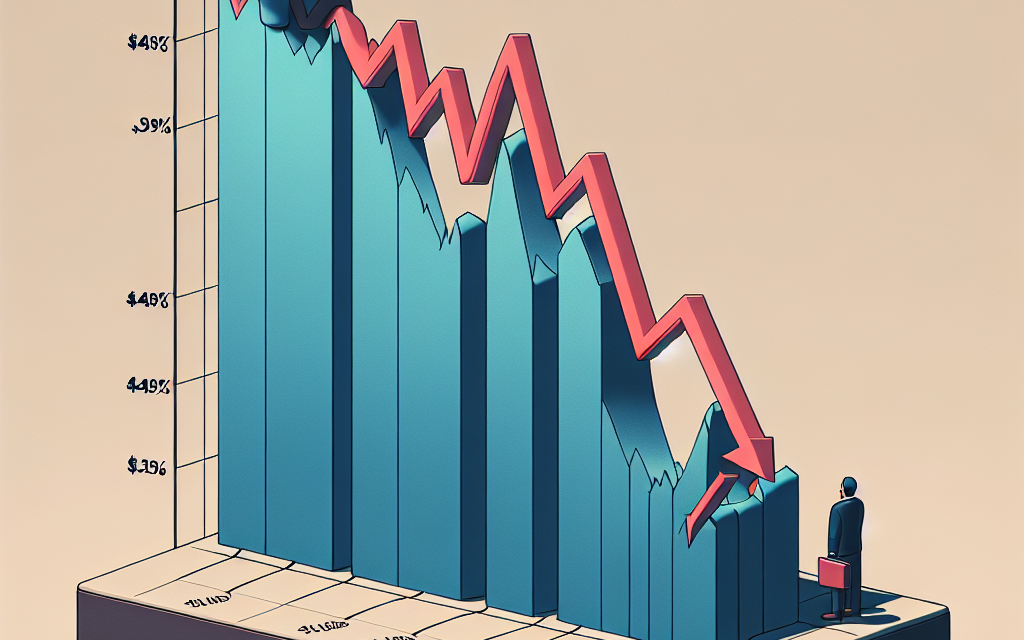“Haidar’s Hedge Fund Hits Turbulence: 33% Loss as $4 Billion Disappears.”
Introduction
Haidar’s hedge fund has recently faced a staggering 33% loss, resulting in the disappearance of approximately $4 billion in assets. This significant downturn has raised concerns among investors and analysts alike, as the fund grapples with the implications of such a dramatic decline. The financial community is closely monitoring the situation, seeking to understand the factors that contributed to this loss and the potential impact on the broader market.
Haidar’s Hedge Fund: Analyzing the 33% Loss
Haidar’s hedge fund has recently come under scrutiny following a staggering 33% loss, which has resulted in the disappearance of approximately $4 billion in assets. This significant downturn has raised questions about the fund’s investment strategies, risk management practices, and overall market conditions that may have contributed to such a dramatic decline. As investors and analysts seek to understand the factors behind this loss, it is essential to delve into the intricacies of Haidar’s investment approach and the broader economic landscape.
To begin with, Haidar’s hedge fund has been known for its aggressive trading strategies, often focusing on high-risk assets that promise substantial returns. However, this approach can be a double-edged sword, particularly in volatile market conditions. The recent economic climate has been characterized by uncertainty, with fluctuating interest rates, geopolitical tensions, and inflationary pressures impacting investor sentiment. These factors have created a challenging environment for hedge funds that rely on rapid market movements to generate profits. Consequently, Haidar’s fund may have found itself on the wrong side of several trades, leading to significant losses.
Moreover, the fund’s reliance on leverage has also come into question. Leverage can amplify returns, but it can equally magnify losses, especially in a downturn. As the market shifted, Haidar’s hedge fund may have faced margin calls, forcing it to liquidate positions at unfavorable prices. This scenario not only exacerbates losses but can also create a cascading effect, further destabilizing the fund’s financial standing. Investors are now left to ponder whether the fund’s management adequately assessed the risks associated with its leveraged positions.
In addition to these internal factors, external market dynamics have played a crucial role in the fund’s performance. The recent downturn in technology stocks, for instance, has had a ripple effect across various sectors, impacting hedge funds heavily invested in these areas. Haidar’s fund, which had a significant allocation to tech equities, may have been particularly vulnerable to this sector’s volatility. As tech stocks plummeted, the fund’s asset base shrank, leading to the reported $4 billion loss. This situation underscores the importance of diversification in investment portfolios, as concentrated positions can lead to catastrophic outcomes in adverse market conditions.
Furthermore, investor sentiment has shifted dramatically in response to the fund’s performance. As news of the 33% loss spread, many investors began to withdraw their capital, fearing further declines. This exodus not only compounds the fund’s challenges but also raises concerns about its long-term viability. The loss of investor confidence can create a self-fulfilling prophecy, where the fund’s struggles lead to further withdrawals, ultimately jeopardizing its ability to recover.
In conclusion, Haidar’s hedge fund faces a critical juncture following its significant 33% loss and the disappearance of $4 billion in assets. The interplay of aggressive investment strategies, reliance on leverage, and adverse market conditions has culminated in a precarious situation for the fund. As investors and analysts continue to scrutinize the fund’s operations, it remains to be seen how Haidar’s management will respond to these challenges. The path forward will likely require a reevaluation of investment strategies, a renewed focus on risk management, and a commitment to restoring investor confidence in an increasingly uncertain financial landscape.
The Impact of $4 Billion Asset Vanish on Investors
The recent announcement regarding Haidar’s hedge fund, which has experienced a staggering 33% loss resulting in the disappearance of $4 billion in assets, has sent shockwaves through the investment community. This significant decline not only raises concerns about the fund’s management practices but also highlights the broader implications for investors who have placed their trust and capital in the fund. As the dust settles, it becomes essential to examine the multifaceted impact of this asset vanishing on the investors involved.
To begin with, the immediate financial repercussions for investors are profound. A 33% loss translates to a substantial reduction in the value of their investments, which can lead to a cascade of negative outcomes. Many investors, particularly those who may have relied on the hedge fund for retirement savings or other long-term financial goals, now face the daunting prospect of reevaluating their financial strategies. The loss of such a significant amount of capital can disrupt carefully laid plans, forcing investors to reconsider their risk tolerance and investment horizons.
Moreover, the psychological impact on investors cannot be understated. The sudden disappearance of $4 billion in assets can lead to feelings of betrayal and mistrust, not only towards the hedge fund itself but also towards the broader financial system. Investors may find themselves grappling with anxiety and uncertainty, questioning their decision-making processes and the reliability of financial advisors. This emotional turmoil can lead to hasty decisions, such as liquidating other investments in an attempt to recover losses, which may further exacerbate their financial situation.
In addition to the immediate financial and psychological effects, the incident raises critical questions about regulatory oversight and the transparency of hedge fund operations. Investors are likely to demand greater accountability and clearer communication from fund managers. The lack of transparency surrounding the circumstances that led to the asset loss may prompt calls for stricter regulations within the hedge fund industry. As a result, investors may become more cautious, seeking out funds that prioritize transparency and adhere to rigorous compliance standards.
Furthermore, the ripple effects of this loss extend beyond individual investors to the broader market. The hedge fund industry is interconnected, and significant losses in one fund can lead to a loss of confidence in others. This erosion of trust can result in a tightening of capital flows, as investors become more risk-averse and hesitant to allocate funds to hedge funds. Consequently, this could lead to a broader market downturn, as reduced investment activity can stifle economic growth and innovation.
As investors grapple with the fallout from Haidar’s hedge fund, it is crucial for them to seek out reliable information and support. Engaging with financial advisors who can provide guidance on navigating this turbulent landscape is essential. Additionally, investors should consider diversifying their portfolios to mitigate risk and protect against future losses. By spreading their investments across various asset classes, they can reduce their exposure to any single fund or market segment.
In conclusion, the impact of the $4 billion asset vanishing from Haidar’s hedge fund is far-reaching, affecting not only the financial standing of individual investors but also the overall trust in the hedge fund industry. As investors confront the consequences of this significant loss, they must remain vigilant and proactive in managing their investments, while also advocating for greater transparency and accountability within the financial system. The lessons learned from this incident may ultimately shape the future of hedge fund investing and influence investor behavior for years to come.
Lessons Learned from Haidar’s Hedge Fund Collapse
The recent collapse of Haidar’s hedge fund, which has seen a staggering 33% loss and the disappearance of $4 billion in assets, serves as a stark reminder of the inherent risks associated with hedge fund investments. This situation not only highlights the volatility of financial markets but also underscores the importance of due diligence and risk management in investment strategies. As investors reflect on the implications of this event, several key lessons emerge that can guide future investment decisions.
First and foremost, the necessity of thorough research cannot be overstated. Investors must conduct comprehensive analyses of hedge funds before committing capital. This includes scrutinizing the fund’s investment strategy, historical performance, and the backgrounds of its managers. In the case of Haidar’s hedge fund, a lack of transparency regarding its investment practices may have contributed to the rapid decline in asset value. Therefore, investors should prioritize funds that demonstrate a clear and consistent investment philosophy, as well as a track record of prudent risk management.
Moreover, diversification remains a fundamental principle in mitigating risk. The concentration of assets in a single fund or strategy can lead to catastrophic losses, as evidenced by Haidar’s situation. By spreading investments across various asset classes, sectors, and geographic regions, investors can reduce the impact of a poor-performing investment on their overall portfolio. This approach not only enhances the potential for returns but also provides a buffer against market volatility. Consequently, investors should consider diversifying their portfolios to safeguard against unforeseen downturns.
In addition to diversification, understanding the liquidity of investments is crucial. Hedge funds often have lock-up periods during which investors cannot withdraw their capital. This can pose significant challenges during times of market distress, as seen in Haidar’s case. Investors should be aware of the liquidity terms associated with their investments and ensure that they have access to sufficient cash reserves to meet their financial needs. By maintaining a balance between liquid and illiquid assets, investors can better navigate periods of market turbulence.
Furthermore, the importance of ongoing monitoring and engagement with fund managers cannot be overlooked. Investors should maintain an active dialogue with their hedge fund managers to stay informed about the fund’s performance and any changes in strategy. Regular communication can provide valuable insights into the fund’s operations and help investors make informed decisions about their investments. In the wake of Haidar’s hedge fund collapse, it is evident that a lack of communication may have contributed to the erosion of investor confidence.
Lastly, the psychological aspect of investing should not be ignored. The emotional responses to market fluctuations can lead to impulsive decisions that exacerbate losses. Investors must cultivate a disciplined approach to investing, focusing on long-term goals rather than short-term market movements. By adhering to a well-defined investment strategy and resisting the urge to react emotionally to market changes, investors can enhance their chances of achieving sustainable returns.
In conclusion, the lessons learned from Haidar’s hedge fund collapse are invaluable for both seasoned and novice investors. By emphasizing the importance of thorough research, diversification, liquidity awareness, ongoing engagement, and emotional discipline, investors can better navigate the complexities of hedge fund investments. As the financial landscape continues to evolve, these principles will remain essential in fostering resilience and success in the face of uncertainty.
Market Trends Leading to Hedge Fund Losses
In recent months, the financial landscape has been marked by significant volatility, leading to substantial losses for various hedge funds, including Haidar’s, which has reported a staggering 33% decline in its assets. This downturn can be attributed to a confluence of market trends that have created a challenging environment for investment strategies traditionally employed by hedge funds. As investors grapple with these shifts, it becomes essential to understand the underlying factors contributing to such dramatic losses.
One of the primary drivers of the recent market turbulence has been the persistent inflationary pressures that have plagued economies worldwide. Central banks, in response to rising prices, have adopted aggressive monetary policies, including interest rate hikes. These measures, while aimed at curbing inflation, have inadvertently led to increased borrowing costs and reduced consumer spending. Consequently, sectors that were once considered safe havens have experienced significant declines, leaving hedge funds exposed to unexpected risks. The impact of these interest rate adjustments has been particularly pronounced in the technology sector, where high-growth companies have seen their valuations reassessed in light of higher discount rates.
Moreover, geopolitical tensions have further exacerbated market instability. The ongoing conflict in Eastern Europe, coupled with trade disputes between major economies, has created an environment of uncertainty that has led to erratic market movements. Investors are increasingly wary of the potential for supply chain disruptions and the implications of sanctions, which have contributed to a lack of confidence in the markets. As a result, hedge funds that rely on global diversification have found their strategies challenged, as correlations between asset classes have increased, diminishing the effectiveness of traditional hedging techniques.
In addition to these macroeconomic factors, the rise of retail trading platforms has transformed the investment landscape. The democratization of trading has empowered individual investors, leading to increased volatility as retail traders react to news and trends in real-time. This phenomenon has created a more unpredictable market environment, where hedge funds, often employing more sophisticated strategies, find it difficult to navigate the rapid shifts in sentiment. The surge in meme stocks and the influence of social media on trading behavior have further complicated the ability of hedge funds to maintain their positions without incurring significant losses.
Furthermore, the performance of hedge funds has been adversely affected by the underperformance of certain asset classes. For instance, the bond market has faced challenges as rising interest rates have led to declining prices. Hedge funds that have historically relied on fixed-income investments as a stabilizing force in their portfolios have found themselves grappling with unexpected losses. This has prompted many fund managers to reassess their asset allocation strategies, seeking alternative investments that may offer better protection against market downturns.
As Haidar’s hedge fund navigates these turbulent waters, it serves as a stark reminder of the inherent risks associated with hedge fund investing. The convergence of inflationary pressures, geopolitical uncertainties, the rise of retail trading, and the underperformance of traditional asset classes has created a perfect storm for many funds. Moving forward, it will be crucial for hedge fund managers to adapt their strategies in response to these evolving market dynamics. By embracing innovative approaches and remaining agile in their investment decisions, they may be better positioned to weather future storms and mitigate the impact of such significant losses.
Risk Management Strategies in Hedge Fund Operations
In the complex world of hedge fund operations, risk management strategies play a pivotal role in safeguarding assets and ensuring long-term viability. The recent news surrounding Haidar’s hedge fund, which faced a staggering 33% loss as $4 billion in assets vanished, underscores the critical importance of robust risk management frameworks. As hedge funds navigate volatile markets, the implementation of effective risk management strategies becomes not only prudent but essential for survival.
To begin with, one of the foundational elements of risk management in hedge funds is the identification and assessment of potential risks. This process involves a thorough analysis of market conditions, economic indicators, and geopolitical events that could impact investment performance. By employing quantitative models and qualitative assessments, hedge fund managers can better understand the risks associated with their portfolios. In the case of Haidar’s fund, it appears that a failure to adequately assess the risks linked to certain investments may have contributed to the significant losses experienced.
Moreover, diversification is a cornerstone of risk management in hedge fund operations. By spreading investments across various asset classes, sectors, and geographic regions, hedge funds can mitigate the impact of adverse market movements. This strategy not only reduces the overall risk profile but also enhances the potential for returns. However, it is crucial to note that diversification must be approached thoughtfully; over-diversification can dilute returns and complicate portfolio management. In light of Haidar’s situation, a reevaluation of diversification strategies may be necessary to prevent similar losses in the future.
In addition to diversification, the use of hedging techniques is another vital aspect of risk management. Hedging involves taking offsetting positions in related securities to protect against potential losses. For instance, hedge funds may utilize options, futures, or other derivatives to hedge against market downturns or specific asset declines. While hedging can be an effective tool for managing risk, it requires a deep understanding of market dynamics and the instruments being used. The recent losses at Haidar’s fund may indicate a misalignment between their hedging strategies and the actual market conditions, highlighting the need for continuous monitoring and adjustment.
Furthermore, the establishment of clear risk limits and guidelines is essential for effective risk management. Hedge funds should define acceptable levels of risk exposure and ensure that all investment decisions align with these parameters. This disciplined approach not only helps in maintaining a consistent risk profile but also fosters accountability among investment teams. In the wake of Haidar’s losses, it is imperative for hedge funds to reinforce their commitment to adhering to established risk limits, thereby minimizing the likelihood of future financial distress.
Lastly, the integration of technology and data analytics into risk management processes cannot be overlooked. Advanced analytics can provide hedge funds with real-time insights into market trends and potential risks, enabling more informed decision-making. By leveraging technology, hedge funds can enhance their ability to respond swiftly to changing market conditions, ultimately improving their risk management capabilities. As the financial landscape continues to evolve, the adoption of innovative tools and methodologies will be crucial for hedge funds aiming to navigate uncertainties effectively.
In conclusion, the challenges faced by Haidar’s hedge fund serve as a stark reminder of the importance of comprehensive risk management strategies in hedge fund operations. By focusing on risk identification, diversification, hedging techniques, adherence to risk limits, and the integration of technology, hedge funds can better position themselves to withstand market volatility and protect their assets. As the industry continues to grapple with inherent risks, a proactive and disciplined approach to risk management will be vital for achieving sustainable success.
The Future of Haidar’s Hedge Fund Post-Loss
The recent announcement regarding Haidar’s hedge fund, which has suffered a staggering 33% loss resulting in the disappearance of $4 billion in assets, raises significant questions about the future of the firm and its investment strategies. As the financial community grapples with the implications of this loss, it becomes essential to analyze the potential pathways forward for Haidar’s fund. The immediate aftermath of such a substantial decline often involves a thorough reassessment of investment strategies, risk management protocols, and overall operational frameworks.
In the wake of this financial setback, it is likely that Haidar’s management team will prioritize transparency and communication with investors. Maintaining investor confidence is crucial, especially when faced with such a dramatic downturn. By openly discussing the factors that contributed to the loss, including market conditions and specific investment decisions, the fund can begin to rebuild trust. Furthermore, engaging in regular updates and providing a clear roadmap for recovery will be vital in reassuring stakeholders that the firm is taking proactive measures to address the situation.
Moreover, the hedge fund may need to consider a strategic pivot in its investment approach. This could involve diversifying its portfolio to mitigate risks associated with concentrated positions that may have led to the recent losses. By exploring alternative asset classes or geographic markets, Haidar’s fund could potentially enhance its resilience against future market volatility. Additionally, incorporating more robust risk management practices, such as stress testing and scenario analysis, could help the fund better navigate uncertain economic landscapes.
As the firm contemplates its future, it may also look to leverage technology and data analytics to inform its investment decisions. The integration of advanced analytical tools can provide deeper insights into market trends and investor behavior, enabling the fund to make more informed choices. By harnessing the power of artificial intelligence and machine learning, Haidar’s hedge fund could enhance its predictive capabilities, ultimately leading to improved performance and reduced risk exposure.
Furthermore, the loss may prompt a reevaluation of the fund’s leadership and governance structures. In times of crisis, strong leadership is essential for guiding an organization through turbulent waters. Haidar’s team may consider bringing in external advisors or industry veterans to provide fresh perspectives and strategic guidance. This infusion of new ideas could be instrumental in revitalizing the fund’s operations and instilling a culture of accountability and innovation.
In addition to internal changes, the hedge fund may also need to reassess its relationships with external partners, including brokers, custodians, and service providers. Strengthening these partnerships can enhance operational efficiency and provide access to valuable resources that support the fund’s recovery efforts. By fostering collaboration and aligning interests with key stakeholders, Haidar’s hedge fund can create a more cohesive and resilient operational framework.
Ultimately, while the loss of $4 billion in assets is undeniably a significant challenge, it also presents an opportunity for Haidar’s hedge fund to emerge stronger and more adaptive. By embracing change, prioritizing transparency, and leveraging technology, the firm can navigate the complexities of the financial landscape and work towards regaining its footing. As the hedge fund industry continues to evolve, those who can learn from setbacks and innovate in response to adversity will be best positioned for long-term success. The path ahead may be fraught with challenges, but with a strategic approach, Haidar’s hedge fund can chart a course toward recovery and renewed growth.
Investor Reactions to Haidar’s Hedge Fund Performance
The recent performance of Haidar’s hedge fund has elicited a range of reactions from investors, particularly in light of the staggering 33% loss that has resulted in the disappearance of approximately $4 billion in assets. This significant downturn has not only raised eyebrows but has also prompted a wave of concern among stakeholders who had previously placed their trust in the fund’s management. As the financial landscape continues to evolve, the implications of such a loss extend beyond mere numbers, affecting investor sentiment and confidence in hedge fund strategies.
Initially, many investors expressed disbelief at the magnitude of the loss. Given the hedge fund’s historical performance, which had been characterized by a series of successful trades and a reputation for astute market analysis, the sudden decline came as a shock. Investors who had been drawn to Haidar’s fund for its promise of high returns are now grappling with the reality of significant financial setbacks. This has led to a growing sense of frustration, as many feel blindsided by the rapid deterioration of their investments.
In the wake of this downturn, some investors have begun to reassess their strategies and risk tolerance. The loss has prompted a broader discussion about the inherent risks associated with hedge funds, particularly those that employ aggressive trading strategies. As investors reflect on their experiences, there is a palpable shift towards a more cautious approach. Many are now prioritizing diversification and seeking to balance their portfolios with more stable investment options, rather than relying solely on high-risk funds that may not deliver consistent returns.
Moreover, the communication from Haidar’s management team has been scrutinized closely. Investors have expressed a desire for greater transparency regarding the factors that contributed to the fund’s poor performance. In an environment where trust is paramount, the lack of clear explanations has only fueled anxiety among stakeholders. As a result, some investors are calling for more frequent updates and detailed insights into the fund’s trading strategies and risk management practices. This demand for transparency reflects a broader trend in the investment community, where stakeholders increasingly seek to understand the underlying dynamics of their investments.
Additionally, the loss has sparked discussions about the broader implications for the hedge fund industry as a whole. Investors are now more acutely aware of the volatility that can accompany hedge fund investments, leading to a reevaluation of their long-term commitments. Some are questioning whether the potential for high returns justifies the risks involved, particularly in light of recent events. This introspection may lead to a shift in capital allocation, with investors gravitating towards more traditional investment vehicles that offer a greater sense of security.
In conclusion, the fallout from Haidar’s hedge fund performance has reverberated throughout the investment community, prompting a reevaluation of strategies and expectations. As investors grapple with the implications of a 33% loss and the disappearance of $4 billion in assets, the call for transparency and a more cautious approach to investing has become increasingly pronounced. The incident serves as a stark reminder of the inherent risks in hedge fund investments, ultimately reshaping investor attitudes and strategies in an ever-evolving financial landscape. As stakeholders navigate this challenging environment, the lessons learned from Haidar’s experience will likely influence their decisions for years to come.
Q&A
1. **What is the main issue faced by Haidar’s hedge fund?**
– The hedge fund is experiencing a 33% loss, resulting in the disappearance of $4 billion in assets.
2. **What percentage of loss did Haidar’s hedge fund incur?**
– The hedge fund incurred a 33% loss.
3. **How much in assets has Haidar’s hedge fund lost?**
– The hedge fund has lost $4 billion in assets.
4. **What could be potential reasons for the hedge fund’s significant loss?**
– Potential reasons could include poor investment decisions, market volatility, or economic downturns.
5. **What impact does a 33% loss have on investor confidence?**
– A 33% loss can significantly erode investor confidence and may lead to withdrawals or reduced investments.
6. **Is this loss indicative of broader market trends?**
– It could be indicative of broader market trends, but specific analysis would be needed to determine the correlation.
7. **What steps might Haidar’s hedge fund take to recover from this loss?**
– The hedge fund may reassess its investment strategy, seek to diversify its portfolio, or implement risk management measures.
Conclusion
Haidar’s hedge fund has experienced a significant setback, with a 33% loss resulting in the disappearance of $4 billion in assets. This decline highlights the volatility and risks inherent in hedge fund investments, raising concerns among investors about the fund’s management strategies and future performance. The situation underscores the importance of risk assessment and diversification in investment portfolios.





